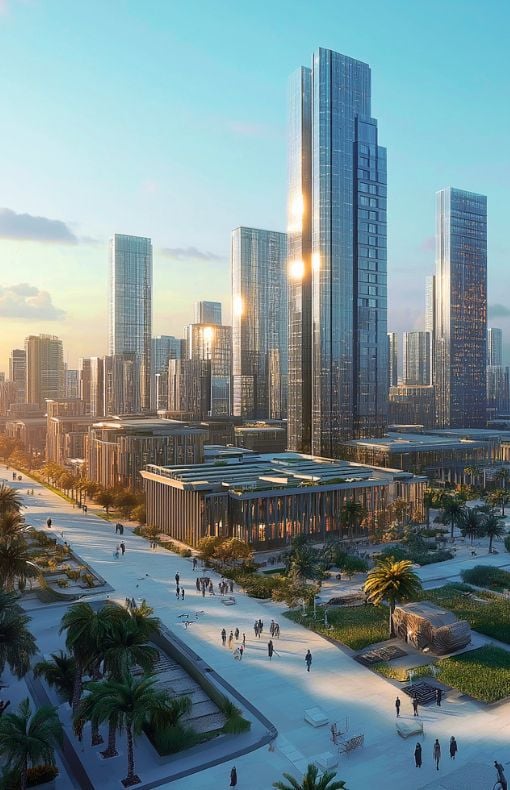Qatar defies global trends with strategic growth in luxury, office, and tourism sectors driven by reform and world-class infrastructure.
INFRASTRUCTURE EXCELLENCE UNDERPINS MARKET STRENGTH
Qatar's real estate sector continues to demonstrate remarkable resilience despite global economic uncertainties, with cross-border investments surging 57% in the first quarter of 2025 and the country leveraging world-class infrastructure to attract premium developments.
Speaking at the Qatar Economic Forum 2025, Minister of Municipality and Chairman of Qatari Diar Real Estate Investment Company Abdullah bin Hamad bin Abdullah Al-Attiyah highlighted that while real estate markets globally face challenges, Qatar's property sector benefits from unique competitive advantages.
At a panel discussion during the forum, Al-Attiyah emphasized the importance of quality over quantity and the location of property projects. In addition, he also underscored the significance of understanding local culture and consumer behaviour as essential to achieving success in real estate development and investment in Qatar and elsewhere in the region.
LUXURY MARKET DEMONSTRATES UNWAVERING STRENGTH
Demand for luxury apartments in areas like Lusail, The Pearl Island, West Bay, and the Marina District continues to be strong, indicating resilient demand for high-end properties. According to Knight Frank's Qatar Real Estate Market Review, luxury apartment rents rose 2.3% over the past year to QAR 11,200 monthly, with West Bay and the Marina District recording particularly robust rental growth of 9.6% and 3.2% respectively.
This luxury segment strength reflects evolving tenant preferences favouring urban, premium residential properties, particularly among expatriates and high-income professionals. However, villa rental rates have declined 7.5% to average QAR 15,085 per month, indicating a need for the market to adapt to shifting tenant preferences and potential oversupply in some communities.
OFFICE MARKET SHOWS ROBUST GROWTH
Qatar's office market is experiencing growth, supported by increased activity from government ministries, state-owned enterprises, and multinational firms, suggesting resilience in the commercial real estate sector. Grade A office space rents increased 3.2% year-on-year, with Lusail commanding QAR 92 per square metre, whilst West Bay's premium properties achieve up to QAR 150 per square metre.
This office market strength reflects Qatar's technological edge and infrastructure advantages. The IMD World Smart Cities Ranking placed Qatar first globally in infrastructure, providing a robust foundation for incorporating artificial intelligence into urban planning and attracting quality-seeking businesses.
GOVERNMENT REFORMS AND INFRASTRUCTURE DRIVE EVOLUTION
Government reforms, infrastructure investments, and the expanding property-linked residency program are driving the market's evolution and resilience. Qatar's commitment to diversification through tourism and entertainment infrastructure represents a key growth driver.
The ambitious Simaisma coastal project, located 40 kilometres north of Doha, exemplifies this strategy. The development will feature the Land of Legends theme park at its heart, alongside a Trump International Golf Club featuring an 18-hole course and luxury villas following a strategic agreement between Qatari Diar and Dar Global.
TOURISM SECTOR REINFORCES MARKET FUNDAMENTALS
Qatar's robust tourism sector and overall economic growth contribute to the stability and resilience of the real estate market. Tourism revenue reached QAR 81.2 billion in 2023, contributing 10.3% of GDP and recording 31% growth year-on-year.
The hospitality sector's expansion further reinforces market fundamentals. With over 1,300 hotel rooms added in 2023 and projections reaching 47,290 keys by 2026, Qatar positions itself as a major Middle East tourism destination, creating sustained demand for real estate across multiple segments.
GLOBAL RECOVERY SIGNALS OPPORTUNITY
While Qatar's market is unique, it also reflects global trends in real estate, including a cautious but growing investment environment. The latest data reveals encouraging signs of recovery across international real estate markets. Transaction values in the Americas reached $93 billion in Q1 2025, marking a 37% increase year-on-year. Europe, the Middle East, and Africa recorded $55 billion in transactions (up 41%), while Asia achieved $36 billion, representing a 20% rise compared to 2024.
MARKET ADAPTS TO ECONOMIC FLUCTUATIONS
While transaction values have seen a slight dip in Q1 2025 compared to Q1 2024, the overall market activity highlights its ability to adapt to economic fluctuations. This adaptation demonstrates the market's maturity and ability to respond to changing conditions while maintaining fundamental strength.
REGIONAL COLLABORATION OVER COMPETITION
Rather than viewing neighbouring Gulf states as competitors, Qatar embraces a collaborative approach. A great example of this is the tourism coordination council that jointly undertakes hospitality-related initiatives that benefit member countries.
This integrated approach, combined with Qatar's safety record, world-class schools, and commitment to Qatar National Vision 2030, positions the country's real estate market to weather global uncertainties whilst capitalising on emerging opportunities in sustainable development and smart city technologies.
LOOKING AHEAD
Qatar's property market resilience stems from multiple factors: strong luxury and office sector performance, comprehensive government reforms, robust tourism growth, and world-class infrastructure. While challenges exist in certain segments like villa rentals, the market's ability to adapt and evolve positions it well for continued growth. The combination of strategic infrastructure investments, expanding residency programs, and collaborative regional approaches ensures Qatar's real estate sector remains attractive to both investors and end-users in an evolving global landscape.
Anthon Garcia | July, 2025


